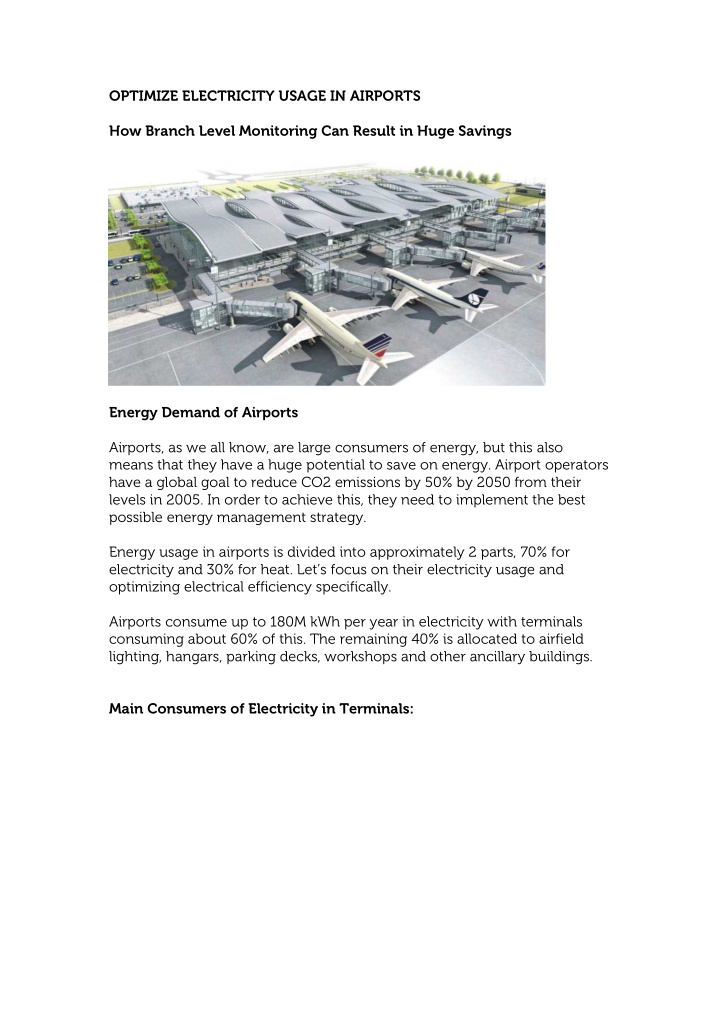



OPTIMIZE ELECTRICITY USAGE IN AIRPORTS How Branch Level Monitoring Can Result in Huge Savings Energy Demand of Airports Airports, as we all know, are large consumers of energy, but this also means that they have a huge potential to save on energy. Airport operators have a global goal to reduce CO2 emissions by 50% by 2050 from their levels in 2005. In order to achieve this, they need to implement the best possible energy management strategy. Energy usage in airports is divided into approximately 2 parts, 70% for electricity and 30% for heat. Let’s focus on their electricity usage and optimizing electrical efficiency specifically. Airports consume up to 180M kWh per year in electricity with terminals consuming about 60% of this. The remaining 40% is allocated to airfield lighting, hangars, parking decks, workshops and other ancillary buildings. Main Consumers of Electricity in Terminals:
Demand for Energy Efficiency Commercial departures are expected to double globally over the next 20 years, making the demand for energy efficiency a priority. In 2012 alone, the passenger growth was 3.9% worldwide. On top of this, the hourly electricity usage in an airport is growing at an annual rate of 6%. Macro vs. Micro Measurements Simply having an overview of the electricity usage is definitely an advantage and a step in the right direction, but the opportunities to constantly improve efficiency, which is critical to obtaining the ISO 500001 are limited. With a system only able to support macro measurements, it is also impossible to add on measurements as you see fit. Imagine, for instance, you are only interested in measuring the cabinets at a gate for now, but after awhile you would like to dig deeper into your usage and figure out exactly what is being used by each device or each circuit breaker so that you can be aware of where changes can be made. In order to do this, it is important to invest in a system that can handle these measurements so you are covered for future improvement. It is typically the case at the moment that electrical usage, load and deviations in jet bridges and cooling systems of each gate or not separately monitored. It is important to measure what is going on at each gate, but also by individual categories, devices and circuits. Below are a few examples of how the Keflavik (Reykjavik) International Airport run by ISAVIA has used branch circuit monitoring to optimize their electricity usage.
ISAVIA Case Study The Keflavik (Reykjavik) International airport run by ISAVIA invested in eTactica, because they needed: 1. A way to monitor how much electricity each of their renters (airlines +shops) is using at each gate and to be able to better allocate costs. In order to do this for the airlines, they wanted to see exactly how much the jet bridges and cooling systems of each gate are using. 2. Decrease cost on their HVAC 3. Monitor load 4. Be able to visualize their electricity usage The eTactica system is measuring: • All cabinets for each gate down to branch level • All HVAC systems • All leases- 15 shops and cafés located in the airport and the airlines Overview of Usage and Cost Allocation ISAVIA is now able to visualise exactly how much electricity is being consumed by each of their renters and allocate their costs by creating categories as seen in the below picture: Decrease cost on HVAC As seen below, the usage on one HVAC system decreased by 22.91% from June 2013 to June 2014. This equals a yearly savings of app. 3.050 EUR/yr just for this one system!
On the system below, usage decreased by 15.28% or approximately 2.070 EUR/yr! The savings for individual systems are large and the airport has only just begun to implement some of what we have suggested to them. So far they have turned down 6 HVAC systems, which will bring them an approximate yearly savings of around 11.500 EUR. We estimate that after they are finished implementing changes, they will be able to save at least twice this much, and this is only on the HVAC. Monitor Load Benefits of identifying overloads: • ISAVIA have been able to identify overloads and solve the problem more quickly.
• eTatica has built in alerts at 100% load. You can also set custom alerts to let you know when the load goes above or below a certain load, to anticipate overloads even sooner. Here is an example of how one overload at ISAVIA looked in the eTactica software. Conclusion It is extremely important with the growing travel and electricity consumption of airports, that they implement a flexible system with the ability to support micro measurements. The potential for branch level monitoring in airports is extensive, as you can see from the above case study. The airport in Keflavik is just one example of one airport measuring only a fraction of their electricity usage, but they have already experienced quite a lot of success with detailed measurements. More importantly, they now have a system flexible enough to dig into their electricity usage even deeper when they are ready to do so. Author: Marta Schluneger, Marketing and Sales Coordinator
Recommend
More recommend